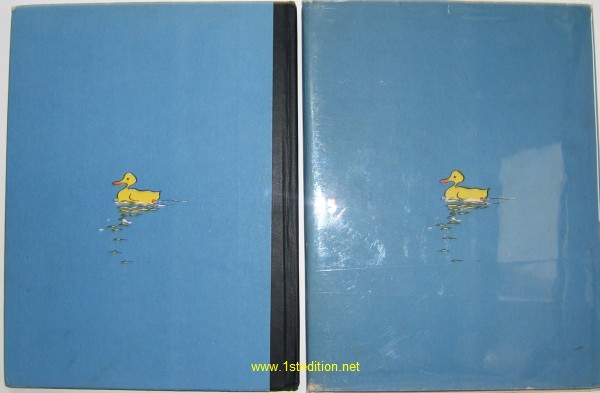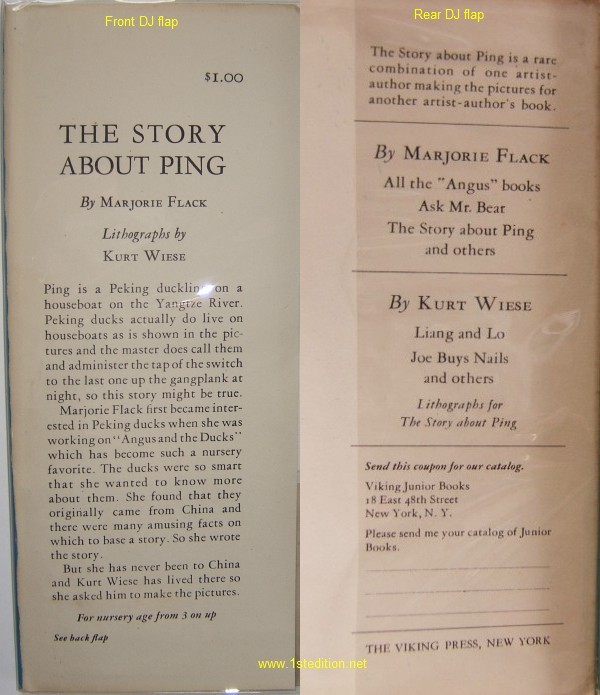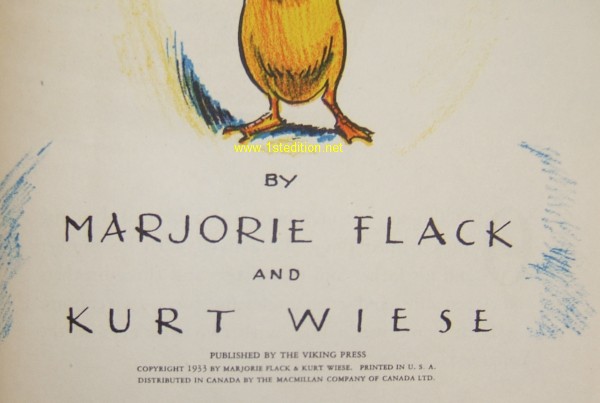First Edition Identification
The Story About Ping; written by Marjorie Flack; illustrated by Kurt Wiese; Viking, 1933.
Childrens Picturebook Price Guide: $740 VG+
The Story About Ping is an early children’s picturebook classic, published only six years after Wanda G’ag’s groundbreaking Millions Of Cats (Coward-McCann, 1927), is a collaboration by two marquis author/illustrators in the children’s book field, Kurt Wiese and Marjorie Flack.
Wiese illustrated over 400 books in his career, and is probably best known for illustrating Felix Salten’s Bambi, along with Walter Brooks long-running series on Freddy the Pig. Wiese also illustrated the 1933 Newbery winner, Young Fu of the Upper Yangtze (1932, $760 VG+), and also the Newbery Honor book, Honk the Moose (1935, $480 VG+), one of the few picturebooks to capture a Newbery award (in the pre-Caldecott award era). Wiese won a Caldecott Honor for his illustrations in You Can Write Chinese (1945, $220 VG+), a book he also authored.
By 1933, Marjorie Flack was already well-known for the three Angus books which she wrote and illustrated. Angus and the Ducks (1930, $620 VG+), Angus and the Cat (1931, $520 VG+), Angus Lost (1932, $440 VG+).
Barbara Bader’s American Picturebooks
From Barbara Bader’s the American Picturebooks, from Noah’s Ark to the Beast Within (page 66):
“Ping– is a real story, a full story, complete in words, but so full of images – the wise-eyed boat, the march of the many ducks, the assortment of boats on the Yangtze, the capture and imprisonment of Ping – that it seems made, as it was, for pictures.
This was one of the first instances in picturebooks proper of a story being written by one person to be pictured by another, and as the first notable instance, the collaboration of an established author and illustrator, it was bound to be influential.
Marjorie Flack didn’t know China, Kurt Wiese did, that was the genesis; the ramifications were many. Artists would not necessarily have to provide material of their own, as they had been doing, and those with no particular talent for writing could contribute. So, independently, could writers, who might in time become writers of picturebooks. As books ceased to spring from pictorial impulses, they might change in nature-broaden, deepen, diversify.
(About Wiese’s rich, luminous zinc lithographs for the original Ping – he redid them when the first set of plates wore out-little need be said except look; with his illustrations for Phil Strong’s Honk the Moose they represent probably his best work in color.)”
The picture on the front board matches the DJ, with a black cloth spine.

The vignette on the back board matches the DJ, with a black cloth spine.

Essential Identification Points
Front DJ flap has synopsis of THE STORY ABOUT PING, with a top right price of “$1.00”
(Note: The DJ price is not required to identify a first printing – the correct flap information is sufficient).
Rear DJ flap begins …
“The Story about Ping is a rare / combination of one artist- / author making the pictures for / another artist-author’s book.”
… then continues with books by Flack, followed by books by Wiese. At the bottom of the rear flap is a coupon to request the Viking Press Junior Book catalog.

The combined copyright/title page concludes with three lines, as follows:
PUBLISHED BY THE VIKING PRESS
-COPYRIGHT 1933 BY MARJORIE FLACK & KURT WIESE. PRINTED IN THE U. S. A.
DISTRIBUTED IN CANADA BY THE MACMILLAN
COMPANY OF CANADA, LTD.
